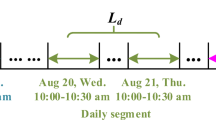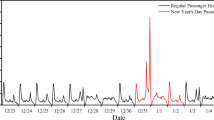Abstract
Millions of residents travel by urban rail transit (URT) every day, and it is meaningful to accurately predict passenger flows for the purpose of intelligent system management. Considering the high traffic volume and complex spatial-temporal traffic patterns, accurate forecasting is quite challenging. Recently, advanced spatial-temporal graph neural networks that combine graph convolution and recurrent units have achieved superior traffic forecasting performance. However, existing methods either simply use a predefined physical network or directly learn latent static graphs by assigning a large number of trainable parameters. Moreover, they only consider capturing local temporal dependencies. However, the passenger flows of URT exhibit both physical adjacent and virtual distant spatial correlations and both local and global temporal fluctuations. In this paper, we propose a Topology Augmented Dynamic Spatial-Temporal Network (TADSTN) to fully exploit the complex spatial-temporal dependencies of passenger flows and make accurate forecasting in URT. Specifically, we first propose a virtual graph generation algorithm with no training parameters to obtain a topology-augmented URT graph, and we also sample multipattern temporal features from raw passenger flow data. Then, we propose a parallel spatial-temporal learning architecture with a time-aware global-level attention mechanism to simultaneously capture both distant and dynamic spatial dependencies and both local and global temporal dependencies of passenger flows. Finally, we evaluate the effectiveness and efficiency of our TADSTN on two real-world datasets.








Similar content being viewed by others
Explore related subjects
Discover the latest articles, news and stories from top researchers in related subjects.Data Availability
The datasets generated during the current study are available in the followings repositories: The pre-processed passenger flow data of CQURT is available at https://github.com/Peiyu-Yi/CQURT-dataset. HZMetro is a widely used public transportation dataset and can be available at https://github.com/LibCity/Bigscity-LibCity-Datasets.
Notes
The pre-processed passenger flow data of CQURT is available at https://github.com/Peiyu-Yi/CQURT-dataset
HZMetro is a widely used public transportation dataset and can be available at https://github.com/LibCity/Bigscity-LibCity-Datasets
References
Liu L, Chen J, Wu H, Zhen J, Li G, Lin L (2020) Physical-virtual collaboration modeling for intra-and inter-station metro ridership prediction. IEEE Trans Intell Transp Syst 23(4):3377–3391
Noursalehi P, Koutsopoulos HN, Zhao J (2021) Dynamic origin-destination prediction in urban rail systems: A multi-resolution spatio-temporal deep learning approach. IEEE Trans Intell Transp Syst 23(6):5106–5115
Wu JL, Lu M, Wang CY (2023) Forecasting metro rail transit passenger flow with multiple-attention deep neural networks and surrounding vehicle detection devices. Appl Intell 1–16
Wang J, Zhang Y, Wei Y, Hu Y, Piao X, Yin B (2021) Metro passenger flow prediction via dynamic hypergraph convolution networks. IEEE Trans Intell Transp Syst 22(12):7891–7903
Xie P, Li T, Liu J, Du S, Yang X, Zhang J (2020) Urban flow prediction from spatiotemporal data using machine learning: A survey. Information Fusion 59:1–12
Guo S, Lin Y, Wan H, Li X, Cong G (2021) Learning dynamics and heterogeneity of spatial-temporal graph data for traffic forecasting. IEEE Trans Knowl Data Eng 34(11):5415–5428
Hochreiter S, Schmidhuber J (1997) Long short-term memory. Neural Comput 9(8):1735–1780
Chung J, Gulcehre C, Cho K, Bengio Y (2014) Empirical evaluation of gated recurrent neural networks on sequence modeling. In: NIPS 2014 Workshop on Deep Learning December 2014
Liu Y, Liu Z, Jia R (2019) Deeppf: A deep learning based architecture for metro passenger flow prediction. Transportation Research Part C: Emerging Technologies 101:18–34
Zhang J, Chen F, Cui Z, Guo Y, Zhu Y (2021) Deep learning architecture for short-term passenger flow forecasting in urban rail transit. IEEE Trans Intell Transp Syst 22:7004–7014
Sun J, Zhang J, Li Q, Yi X, Liang Y, Zheng Y (2020) Predicting citywide crowd flows in irregular regions using multi-view graph convolutional networks. IEEE Trans Knowl Data Eng 34(5):2348–2359
Zhang X, Sun Y, Guan F, Chen K, Witlox F, Huang H (2022) Forecasting the crowd: An effective and efficient neural network for citywide crowd information prediction at a fine spatio-temporal scale. Transportation Research Part C: Emerging Technologies 143:103854
Zhang J, Chen F, Guo Y, Li X (2020) Multi-graph convolutional network for short-term passenger flow forecasting in urban rail transit. IET Intel Transport Syst 14(10):1210–1217
Bai L, Yao L, Li C, Wang X, Wang C (2020) Adaptive graph convolutional recurrent network for traffic forecasting. Adv Neural Inf Process Syst 33:17804–17815
Wu Z, Pan S, Long G, Jiang J, Zhang C (2019) Graph wavenet for deep spatial-temporal graph modeling. In: Proceedings of the 28th International Joint Conference on Artificial Intelligence pp. 1907–1913
Bui K-HN, Cho J, Yi H (2022) Spatial-temporal graph neural network for traffic forecasting: An overview and open research issues. Appl Intell 52(3):2763–2774
Yuan H, Li G, Bao Z (2022) Route travel time estimation on a road network revisited: Heterogeneity, proximity, periodicity and dynamicity. Proceedings of the VLDB Endowment 16(3):393–405
Huang F, Yi P, Wang J, Li M, Peng J (2022) Time-series forecasting with shape attention. In: 2022 IEEE International Conference on Systems, Man, and Cybernetics (SMC), pp. 3299–3304. IEEE
Zhao L, Song Y, Zhang C, Liu Y, Wang P, Lin T, Deng M, Li H (2019) T-gcn: A temporal graph convolutional network for traffic prediction. IEEE Trans Intell Transp Syst 21(9):3848–3858
Ma D, Song X, Li P (2020) Daily traffic flow forecasting through a contextual convolutional recurrent neural network modeling inter-and intra-day traffic patterns. IEEE Trans Intell Transp Syst 22(5):2627–2636
Tedjopurnomo DA, Bao Z, Zheng B, Choudhury FM, Qin AK (2020) A survey on modern deep neural network for traffic prediction: Trends, methods and challenges. IEEE Trans Knowl Data Eng 34(4):1544–1561
Fang Z, Cheng Q, Jia R, Liu Z (2018) Urban rail transit demand analysis and prediction: A review of recent studies. In: International Conference on Intelligent Interactive Multimedia Systems and Services pp. 300–309. Springer
Wang X, Zhang N, Zhang Y, Shi Z (2018) Forecasting of short-term metro ridership with support vector machine online model. J Adv Transp 2018
He K, Ren G, Zhang S (2020) Passenger flow prediction for urban rail transit stations considering weather conditions. In: Green, Smart and Connected Transportation Systems: Proceedings of the 9th International Conference on Green Intelligent Transportation Systems and Safety pp. 661–673. Springer
Chen C, Li K, Teo SG, Zou X, Li K, Zeng Z (2020) Citywide traffic flow prediction based on multiple gated spatio-temporal convolutional neural networks. ACM Transactions on Knowledge Discovery from Data (TKDD) 14(4):1–23
Wei Q, Qiu Y, Wen Y (2022) Cluster-based spatiotemporal dual self-adaptive network for short-term subway passenger flow forecasting. Appl Intell 52(12):14137–14152
Scarselli F, Gori M, Tsoi AC, Hagenbuchner M, Monfardini G (2008) The graph neural network model. IEEE Trans Neural Networks 20(1):61–80
Bruna J, Zaremba W, Szlam A, LeCun Y (2014) Spectral networks and deep locally connected networks on graphs. In: 2nd International Conference on Learning Representations, ICLR 2014
Jiang W, Luo J (2022) Graph neural network for traffic forecasting: A survey. Expert Syst Appl 207:117921. https://doi.org/10.1016/j.eswa.2022.117921
Liu L, Zhen J, Li G, Zhan G, He Z, Du B, Lin L (2020) Dynamic spatial-temporal representation learning for traffic flow prediction. IEEE Trans Intell Transp Syst 22(11):7169–7183
Li Y, Yu R, Shahabi C, Liu Y (2018) Diffusion convolutional recurrent neural network: Data-driven traffic forecasting. In: International Conference on Learning Representations
Yi P, Huang F, Peng J (2021) A fine-grained graph-based spatiotemporal network for bike flow prediction in bike-sharing systems. In: Proceedings of the 2021 SIAM International Conference on Data Mining (SDM) pp. 513–521. SIAM
Kipf TN, Welling M (2016) Semi-supervised classification with graph convolutional networks. In: International Conference on Learning Representations
Han Y, Wang S, Ren Y, Wang C, Gao P, Chen G (2019) Predicting station-level short-term passenger flow in a citywide metro network using spatiotemporal graph convolutional neural networks. ISPRS Int J Geo Inf 8(6):243
Hao S, Lee D-H, Zhao D (2019) Sequence to sequence learning with attention mechanism for short-term passenger flow prediction in large-scale metro system. Transportation Research Part C: Emerging Technologies 107:287–300
Huang F, Yi P, Wang J, Li M, Peng J, Xiong X (2022) A dynamical spatial-temporal graph neural network for traffic demand prediction. Inf Sci 594:286–304
Huang F, Qiao S, Peng J, Guo B, Xiong X, Han N (2019) A movement model for air passengers based on trip purpose. Physica A 525:798–808
Tobler WR (1970) A computer movie simulating urban growth in the detroit region. Econ Geogr 46(sup1):234–240
Defferrard M, Bresson X, Vandergheynst P (2016) Convolutional neural networks on graphs with fast localized spectral filtering. Adv Neural Inf Process Syst 29:3844–3852
Atwood J, Towsley D (2016) Diffusion-convolutional neural networks. In: Advances in Neural Information Processing Systems, pp. 1993–2001
Yuan H, Li G, Bao Z, Feng L (2021) An effective joint prediction model for travel demands and traffic flows. In: 2021 IEEE 37th International Conference on Data Engineering (ICDE) pp. 348–359. IEEE
Wang X, Ma Y, Wang Y, Jin W, Wang X, Tang J, Jia C, Yu J (2020) Traffic flow prediction via spatial temporal graph neural network. In: Proceedings of The Web Conference 2020 pp. 1082–1092
Vaswani A, Shazeer N, Parmar N, Uszkoreit J, Jones L, Gomez AN, Kaiser Ł, Polosukhin I (2017) Attention is all you need. In: Advances in Neural Information Processing Systems pp. 5998–6008
Acknowledgements
This work is partially supported by the Sichuan Science and Technology Program (2022YFG0034, 2023YFG0112), the Postdoctoral Interdisciplinary Innovation Fund (10822041A2137), the Intelligent Terminal Key Laboratory of Sichuan Province (SCITLAB-20001), and the Cooperative Program of Sichuan University and Yibin (2020CDYB-30).
Author information
Authors and Affiliations
Corresponding authors
Ethics declarations
Human Participants
This study does not contain any studies with human participants or animals performed by any of the authors.
Conflict of Interests
The authors declare that they have no conflict of interest.
Additional information
Publisher's Note
Springer Nature remains neutral with regard to jurisdictional claims in published maps and institutional affiliations.
Rights and permissions
Springer Nature or its licensor (e.g. a society or other partner) holds exclusive rights to this article under a publishing agreement with the author(s) or other rightsholder(s); author self-archiving of the accepted manuscript version of this article is solely governed by the terms of such publishing agreement and applicable law.
About this article
Cite this article
Yi, P., Huang, F., Wang, J. et al. Topology augmented dynamic spatial-temporal network for passenger flow forecasting in urban rail transit. Appl Intell 53, 24655–24670 (2023). https://doi.org/10.1007/s10489-023-04651-z
Accepted:
Published:
Issue Date:
DOI: https://doi.org/10.1007/s10489-023-04651-z




